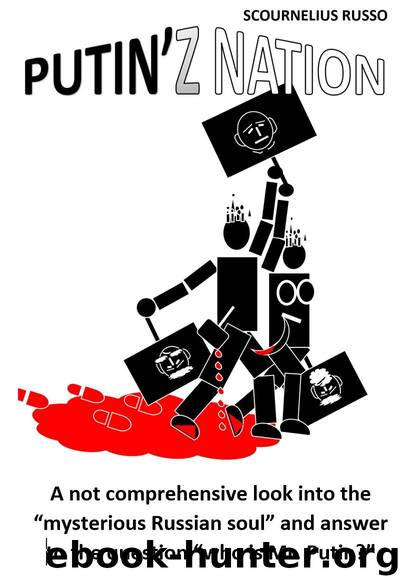Putin'Z Nation by Russo Scournelius

Author:Russo, Scournelius
Language: eng
Format: epub
Published: 2022-12-14T00:00:00+00:00
Social groups and perceived societal fragmentation
âMany misfortunes have come into the world because of bewilderment and things left unsaid.â
Fyodor Dostoevsky about Russian Literature
Putinâz nation and other peoples living in Russia are difficult to disentangle into clearly defined social groups. Unlike tsarist Russia where babies were born into relatively certain futures, Soviet society initially was a mix of various classes which eventually got equalized in the simplest form â the so-called class of peasants and workers. The living conditions of the peasant and workers were different. Education levels were a bit higher among workers. Their life routine was different. Yet it is impossible to distinguish value sets between a worker and a peasant beyond their professional occupation. Workers mostly consisted of the peasants that moved to towns and cities during mass economic and forced reallocations. Peasants that remained in villages had fewer rights and did not have passports until 1974. They had less access to spending money and consumed much of the food they have grown themselves. In other words, identifiable differences in lifestyle depend on profession or age category. Letâs explore this first.
With Soviet Unionâs death, many republics with relatively high fertility rates were gone. Children and students share in Russia declined to 24% in 2018 from 27% in 1980 in the Soviet Union. The scale shall be noted too â 35 million against 74 million accordingly.
Children and students aside, letâs look at pensioners. In 2018, 30% of the living population in Russia were pensioners or an army of 44 million people (equal to the size of Ukraine). That is 12% more than in the Soviet Union in 1980. This group in 2018 was larger than the total population of 55+ which equaled 42 million. That suggests that about 2 million pensioners came from professions that allow early retirement (mostly army and law enforcement). Women accounted for around 60% of the pensionersâ group.
Download
This site does not store any files on its server. We only index and link to content provided by other sites. Please contact the content providers to delete copyright contents if any and email us, we'll remove relevant links or contents immediately.
The Secret History by Donna Tartt(16606)
The Social Justice Warrior Handbook by Lisa De Pasquale(11485)
Thirteen Reasons Why by Jay Asher(7780)
This Is How You Lose Her by Junot Diaz(5753)
Weapons of Math Destruction by Cathy O'Neil(5029)
Zero to One by Peter Thiel(4816)
The Myth of the Strong Leader by Archie Brown(4785)
Promise Me, Dad by Joe Biden(4440)
Stone's Rules by Roger Stone(4412)
Beartown by Fredrik Backman(4403)
How Democracies Die by Steven Levitsky & Daniel Ziblatt(4392)
The Fire Next Time by James Baldwin(4336)
100 Deadly Skills by Clint Emerson(4070)
A Higher Loyalty: Truth, Lies, and Leadership by James Comey(4024)
Rise and Kill First by Ronen Bergman(4008)
The David Icke Guide to the Global Conspiracy (and how to end it) by David Icke(3875)
The Farm by Tom Rob Smith(3869)
Secrecy World by Jake Bernstein(3773)
The Doomsday Machine by Daniel Ellsberg(3725)
